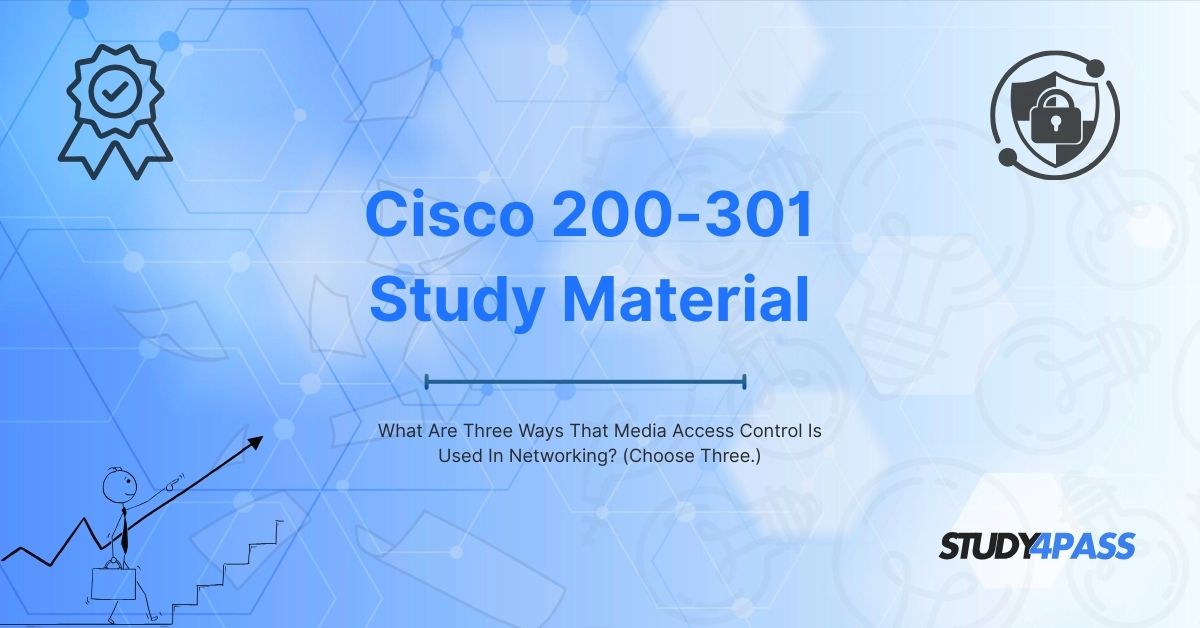Introduction
Media Access Control (MAC) is a crucial concept in networking, particularly in Ethernet-based networks. It determines how devices share a communication medium, ensuring efficient and collision-free data transmission. For students preparing for the Cisco CCNA 200-301 Exam or the CCNA 1 v7 Ethernet Concepts Exam, understanding MAC mechanisms is essential.
This article explores three primary ways MAC is used in networking:
- CSMA/CD (Carrier Sense Multiple Access with Collision Detection)
- CSMA/CA (Carrier Sense Multiple Access with Collision Avoidance)
- MAC Addressing and Switching
Additionally, we recommend Study4Pass as an excellent resource for CCNA exam preparation, offering practice tests, study guides, and expert explanations.
CSMA/CD (Carrier Sense Multiple Access with Collision Detection)
Definition and Function
CSMA/CD is a MAC protocol used primarily in wired Ethernet networks (half-duplex mode). It helps devices detect and recover from data collisions when multiple devices transmit simultaneously.
How CSMA/CD Works?
- Carrier Sense: A device checks if the network is idle before transmitting.
- Multiple Access: If the medium is free, multiple devices can attempt to transmit.
- Collision Detection: If two devices transmit at the same time, a collision occurs.
- Backoff Algorithm: The devices wait for a random time before retransmitting.
Importance in Networking
- Prevents data corruption in shared networks.
- Ensures fair access to the transmission medium.
- Mostly used in legacy Ethernet (10BASE-T, 100BASE-TX).
CCNA Exam Relevance
- Understanding CSMA/CD is crucial for troubleshooting Ethernet issues.
- Questions may cover collision domains and network efficiency.
CSMA/CA (Carrier Sense Multiple Access with Collision Avoidance)
Definition and Function
Unlike CSMA/CD, CSMA/CA is used in wireless networks (Wi-Fi) where collision detection is difficult due to the hidden node problem.
How CSMA/CA Works?
- Carrier Sense: The device checks if the wireless channel is free.
- Random Backoff: If busy, it waits for a random interval before retrying.
- ACK Mechanism: The receiver sends an acknowledgment (ACK) to confirm successful transmission.
- RTS/CTS (Optional): Request-to-Send/Clear-to-Send helps avoid hidden node issues.
Importance in Networking
- Reduces collisions in Wi-Fi networks.
- Essential for 802.11 (Wi-Fi) standards.
- Improves reliability in high-traffic wireless environments.
CCNA Exam Relevance
- Questions may compare CSMA/CD vs. CSMA/CA.
- Understanding wireless MAC protocols is key for modern networks.
MAC Addressing and Switching
Definition and Function
Every network device has a unique MAC address (48-bit identifier) burned into its NIC. Switches use MAC addresses to forward frames efficiently.
How MAC Addressing Works?
- Uniqueness: Each MAC address is globally unique (OUI + Vendor ID).
- Switching Table: Switches learn MAC addresses and map them to ports.
- Frame Forwarding: Switches use MAC tables to send frames only to the correct destination.
Importance in Networking
- Enables efficient Layer 2 communication.
- Reduces unnecessary network traffic (unlike hubs).
- Essential for VLANs and security (MAC filtering).
CCNA Exam Relevance
- Questions may cover MAC table operations.
- Understanding switching vs. broadcasting is crucial.
Why Study4Pass is the Best for CCNA Exam Preparation?
Preparing for the Cisco CCNA 200-301 Exam or the CCNA 1 v7 Ethernet Concepts Exam requires reliable study materials. Study4Pass offers:
Latest Practice Tests – Simulate real exam conditions.
Detailed Explanations – Understand concepts, not just memorize answers.
Exam-focused Content – Covers all CCNA topics, including MAC protocols.
Affordable Pricing – High-quality resources at competitive rates.
For students aiming to pass the CCNA Exam on the first attempt, Study4Pass provides structured learning paths and expert guidance.
Conclusion
Media Access Control (MAC) is fundamental in networking, ensuring efficient and orderly data transmission. The three key methods discussed are:
- CSMA/CD – For wired Ethernet collision management.
- CSMA/CA – For wireless networks to avoid collisions.
- MAC Addressing & Switching – For efficient frame forwarding.
Mastering these concepts is essential for the Cisco CCNA 200-301 Exam and CCNA 1 v7 Ethernet Concepts Exam. For the best preparation, Study4Pass offers comprehensive study materials, practice tests, and expert support to help you succeed.
Start your CCNA journey today with Study4Pass and achieve certification with confidence!
Special Discount: Offer Valid For Limited Time “200-301 Exam Questions”
Sample Questions for Cisco 200-301 Exam
Actual exam questions from Cisco's 200-301 Test
1. What are three ways that Media Access Control (MAC) is used in networking? (Choose three.)
A. Error detection in data frames
B. Uniquely identifying network devices
C. Encrypting data transmissions
D. Controlling access to the physical network medium
E. Assigning IP addresses dynamically
2. Which of the following is a function of MAC in networking?
A. Routing packets between different networks
B. Providing secure VPN connections
C. Regulating data transmission over a shared medium
D. Resolving domain names to IP addresses
3. How does a MAC address assist in network communication?
A. By acting as a logical endpoint for applications
B. By uniquely identifying a device’s physical network interface
C. By storing website DNS records
D. By fragmenting large data packets
4. Which of these is NOT a use of Media Access Control?
A. Preventing collisions in Ethernet networks
B. Filtering traffic using MAC address tables in switches
C. Configuring firewall rules based on IP addresses
D. Enabling Layer 2 communication
5. In Ethernet networks, MAC protocols help:
A. Establish Wi-Fi encryption standards
B. Determine which device transmits data first on a shared medium
C. Convert analog signals to digital signals
D. Block unauthorized users at the application layer


